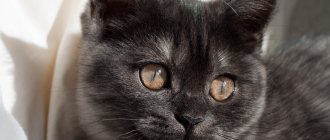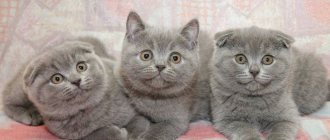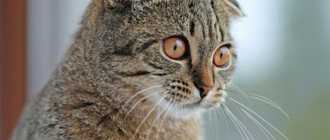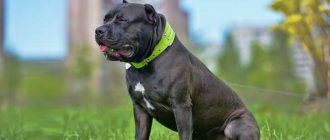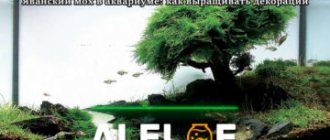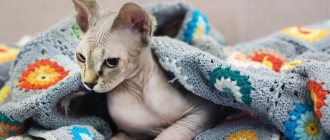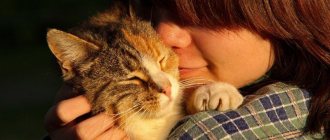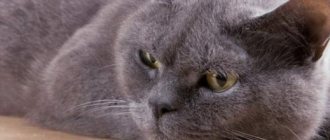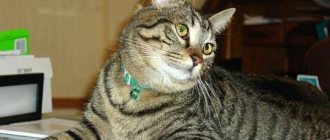Buyers usually have no difficulties purchasing a purebred pet. But choosing the right kitten with whom all family members will feel comfortable does not happen quickly. The animal pleases the owner, and the person must understand the degree of responsibility for the life and health of the pet. Who is closer to family: an important Briton or a playful Scot. To understand this issue, you need to know the difference between British kittens and Scottish babies.
History of the British and Scots
The dynasty of fold-eared beauties dates back to the 60s of the 20th century. Scotland is considered the homeland of pets with folded ears. The ancestor of unusual babies is called the cat Susie, whose litter included both lop-eared and straight-eared pets.
Representatives of British cats were brought to England by Roman soldiers. The dexterity and skills of the mousecatchers attracted the attention of the residents. Breeders were interested in the appearance of the plush cat, and at a specialized exhibition in 1871 in the capital of the country, a decision was made to breed British cats as an independent breed.
Differences between the British and the Scots
Differences between the British and the Scots are observed in the formation of body parts, the cat’s character and habits.
| Peculiarities | British cat | Scottish cat |
| Pet head | Large round with pronounced cheeks, upturned nose, protruding jaw | Head proportional to the body, smaller in size than the British |
| Eyes | Wide open, large. The color is most often shades of copper. | Large, round, with an expression of surprise in their eyes. Due to the shape of the eyes it looks like an owlet. Color is the same as coat color |
| Ears | Straight, small, wide at the base | Small, erect or hanging |
| Paws | Powerful, with large pads | Medium size, strong, mobile fingers |
| Wool | According to the standard: plush, dense, short | Short, long, flowing, without clumps, with dense undercoat: depends on the breed type |
| Tail | Small or medium length, round at the end | Large, no creases, movable |
| Colors | The most common colors are around 30-35 shades. In total, more than 60 types of color are known. Main tone - blue | The color is identical to the color of the eyes, there are about 60-70 options |
External features of the British
The expression “Cheshire cat smile” will help answer the question of how British cats differ from Scottish ones. It most accurately describes the features of the British man’s appearance: large cheeks, prominent cheekbones and the same powerful head and large body.
Differences from the Scots
One of the differences between a British cat and a Scottish cat: fur. The first one has a plush, velvety, rather short one. The second is the owner of a long, pleasant to the touch, or short, thick fur coat.
External features of the Scots
The slender paws of a Scottish cat and a long fluffy tail are other ways that a Scotsman differs from a Briton. Due to the structure of the size of the limbs, a longhaired cat looks taller and slimmer. The pads of both individuals are plump with separated toes.
The head of Scottish cats is much rounder, unlike British cats, the cheeks are not so clearly defined.
Differences from the British
Scottish kittens are born with straight ears; after 3-4 weeks it becomes clear which breed the owner has in front of them. In some babies, at the age of one month, the ears begin to hang forward, towards the head, and a fold forms. This is how the hearing organs of folds are formed.
There is a misconception about the presence of British kittens with folded ears: this is not true. There are no British Folds.
British and Scottish differences in the photo
A Scottish Fold cat may give birth to babies with straight ears or bent ears. The baby with the second option, in the photo, is called Scottish Fold.
External differences
There are several visible differences between British cats and pets of Scottish blood.
| External characteristics | British | Scots |
| Ears | Wide set and straight. | Straights are straight, but more tapered and closely spaced than the British. They have softer ear cartilages to the touch. Folds have flattened and curled ears of small size. |
| Head | Large, round in shape and with a pronounced chin. The muzzle has a serious expression. | Round in shape, but smaller in size. You can read tenderness on the face. |
| Eyes | Round, large and widely spaced. | Round, but smaller. |
| Cheeks | Short hair creates a visual illusion, as if the pet's cheeks are touching the shoulders. | Small cheeks. |
| Nose | Straight and wide. | More elongated shape. |
| Legs | Shortish, with powerful pads. | Long, making the animal look taller. |
| Tail | Thick, not very long and with a rounded tip. | Long, tapering towards the end and more mobile. |
| Wool | Thick and plush. | Less dense and silky. |
| Weight | From 4 to 9 kilograms. | From 3 to 6 kilograms. |
| Skeleton | Stocky body with a pronounced chest and a short, faintly visible neck. | The body is medium in size and has an elongated shape. |
In addition to the differences, there are a number of similarities between the British and Scottish breeds: round eyes, pronounced whisker pads and a rounded head.
British breed
Depending on the external features, there are varieties of the British breed:
- British shorthair cat, with dense coat and thick undercoat;
- British chinchilla, a cat with a unique coloring;
- British Longhaired Highlander.
The British Longhaired Highlander was the result of mating a shorthaired male with a Persian cat. From the Persians, the offspring inherited a long thick fur coat.
The British are bigger than the Scots
The weight of a British cat is greater than that of a Scottish furry representative. An adult animal reaches 7-8 kg. There are 12-kilogram pets of this breed.
Chartez and British differences
In the Middle Ages, a breed of short-haired Carthusian cat, the Chartreux, appeared in France. Outwardly, these pets are similar to British babies; inexperienced owners may mistake the Carthusian pet for a large plush pet.
The main difference between the Chartreuse and the British is the structure of the former's head, which has an elongated shape.
Other differences between Chartreuse and British:
- Chartreuse has thin cheeks.
- Its tail is wide at the base and narrow at the tip.
- Coat color: various shades of gray.
Origin
British
The British breed began to be developed in the 19th century. Since antiquity in the ancient Roman era, the history of the aristocratic breed began. It is believed that the British breed originated from gray cats that lived in North Africa and Southern Europe. The aboriginal population began to domesticate them and, with the Roman legionnaires, the cats were brought to the British Isles.
The ancestors of these cats were distinguished by good health and took root well in the cool climate of England.
G. Weier brought out the British: he selected gray cats with similar external features for mating. Weyer then organized an exhibition of these cats in 1861, after which British straight-eared cats gained great popularity.
British
Scots
Scottish cats with floppy ears appeared about 100 years later than the British breed. Scots with floppy ears were bred by accident in 1959. Farmer W. Ross saw a white cat with floppy ears named Susie among his neighbors. The ancestors of this cat were mongrel.
In 1961, the Ross family acquired a fold-eared kitten from Susie and named her Snooks. The owner of the cat kept her cubs, and then the offspring participated in exhibitions and breeding. The lop ear was caused by a gene mutation in the cartilage.
Attention! There is no breed of British fold cat, and there are differences between the British and the Scots in appearance, ears and character traits.
Scottish breed
The beloved Scottish breed Scottish Straights are confused with British Shorthairs. The Scots have straight ears pushed forward, the British have wide ears with rounded tips.
Differences between Scottish Fold and Scottish Straight
In turn, Scottish cats are divided into Scottish Folds and Scottish Straights. These are animals with a short coat. The ears of the folds are pressed to the head, forming a fold, this is how the lop-eared gene acts on the cartilaginous joints of pets. There is a large distance between the ears.
For straights this gap is much smaller. The base of their hearing organs is narrow.
Highland fold and highland straight differences
Highlands are considered a variety of straights and folds. Individuals appeared as a result of long-term selection work. The breed is accepted by felinologists all over the world. According to the standard, Highland Folds and Highland Straights have luxurious, long hair. Pets also have a long, fluffy tail.
Difference in character
Typically, British pets are purchased by working people who spend a long time outside the home. Plush pets can be alone in the apartment without fear of loneliness. Importance, aristocratic behavior and sedateness - these qualities distinguish the British from other breeds.
Animals do not like to be picked up or squeezed. The cat itself will approach the owner for a portion of affection. The British are prone to depression, cats need to be interested in active games. Representatives of this breed quickly gain weight; it is important to prevent British pets from becoming obese, especially after castration or sterilization. Extra pounds are an additional burden on the internal organs of pets.
The Scots are easier to communicate with people and other animals. Playful, playful cats resemble dogs in their habits: they can fetch an object thrown by the owner, hide, and frolic with other kids. Scottish dogs are more amenable to education and training. They quickly acquire hygiene skills.
Representatives of the breeds are very clean animals; they will refuse a dirty tray and will not eat from dirty dishes. If they feel unwell, their behavior will attract the attention of family members to their problems. Scottish and British cat in the photo.
British/Scottish mix
Initially, breeders bred British and Scottish representatives of the breed. But over time, breeders noticed: such a union produces weak babies with genetic diseases of the spine and joints.
Currently, cross-breeding between Britons and Scots is prohibited. A conscientious owner will not allow the appearance of sick offspring. To get healthy kittens, Scottish Straights are bred with Scottish Folds. The best result is considered to be mating provided that partners of the same color and from the same felinological club are selected.
You also cannot cross fold-eared cats with a fold-eared cat. The presence of the lop ear gene will lead to diseases in the born kittens.
Crossbreed with mestizo
Mating with a mixed breed spoils the breed's advantages; such pets are not exhibited at shows and felinological organizations do not breed them.
Who is better to choose
It is difficult to say which breed is better, British or Scottish. The choice of a pet is based on the preferences of the future owner, daily routine and rhythm of life. The British cat quickly becomes attached to the house and considers himself a full member of the family. He likes to be left alone for a long time, but a purebred animal needs proper care and timely education.
The British man’s appearance is brutal, his behavior is very important. It is no coincidence that previously only the rich segments of the population could afford to keep such cats. The facial expressions of pets are interesting and funny. Up to a year old, babies are playful and active, but closer to the age of two, the cat’s habits change, she becomes calm and sleepy. The baby loves to sleep, lounging on the plush back.
The Scottish cat, as a kitten and as an adult, is playful and noisy. He will run around at night or run around the apartment with a rubber mouse.
The Scottish woman loves children, she likes the attention of the owner and family members. Everything in it is for a large and noisy company:
- A funny pose in which your pet often sits: on its tail, with its long legs outstretched.
- Or the famous gopher stand, when the baby stretches vertically on its hind legs, tucking its front legs.
- Ability to walk on a leash and follow various commands.
This cat combines the qualities of cats and dogs. Caring for a cat is not difficult. The Scottish favorite cannot stand heights: flying from the top shelves is not possible for the animal due to the structure of its limbs.
How to distinguish a British kitten from a Scottish one
The difference between British and Scottish cats is obvious. It makes no sense for nursery owners to deceive those who want to buy babies of a certain breed.
The smaller the kitten, the more difficult it is to distinguish a British cat from a Scottish pet. Characteristic signs appear as the baby grows older. Therefore, it is better to buy a baby at the age of 2-3 months.
By this time, the Scotchfold ears, straight from birth, will acquire the desired fold. The eye color will gradually begin to acquire a constant shade that matches the color of the animal's coat. A mandatory item when choosing a kitten is to check the baby's tail: for a fold-eared baby, it should be long and mobile. The British have a powerful, thick tail, much shorter than that of the Scot.
The main points of difference between kittens of the British and Scottish breeds, which people pay attention to when choosing babies:
| British kittens | Scottish kittens |
| Heavier paws, clubfoot when walking | Long light limbs |
| Chubby cheeks | Cheekbones are not very pronounced |
| Large baby | Small in size |
| Round head | Elongated skull shape |
Babies do not differ much in their habits: up to a year old, representatives of these breeds are active and respond to play with pleasure. The difference in behavior between the British and Scottish cats will be noticeable in later life.
To the touch, the Scottish have fur that is more fluffy and soft, gliding, while the British have dense and thick fur. An inexperienced buyer will not be able to independently determine what breed the cub belongs to. The difference in behavior between the British and Scottish cats will be noticeable in later life.
Character of British cats
You can indirectly determine a British kitten by its character. The kids are calm and serious. Animals can be quickly trained to do something without much difficulty. Of course, kittens are very playful, like all felines, but they prefer to play alone. It is enough to make one toy for them so that they do not do mischief, and that will be more than enough.
With age, animals become imposing and proud. Felines try, on the one hand, to stay away from people, but on the other, to make sure that they still get time. The British are devoted to their owners and miss them greatly when they are away, but the animals will never show it. If you want to have such a furry friend in your house, then you can choose a girl kitten (because “ladies” are more affectionate) and give all the kindness to your favorite.
British or Scottish: the choice is yours
People are thinking about buying a specific pet and note important conditions for their choice. They take a cat to a large family with small children or to a busy person who works a lot and loves silence in the house. Or maybe a son or daughter will just like the fat-cheeked baby Briton, and all family members will support the freedom-loving animal.
Whether a playful Scottish pet or a British cat comes to the family: every animal needs care. Information about the external characteristics, character and behavior of animals will help you decide on the choice of your baby.
Who is better to give preference to?
When choosing a pet, it is important to consider its temperament and character. British cats are more suitable for people who are willing to tolerate the freedom-loving nature of a cat. Scots will fit perfectly into a family with children or other pets.
All the described differences and features will help to correctly identify a Scotsman or a Briton, however, to be completely sure, it is recommended to seek help from a felinologist. And don’t forget: a pet will become a member of your family, so purchasing it should be approached with the utmost responsibility.
Did you like the article?
